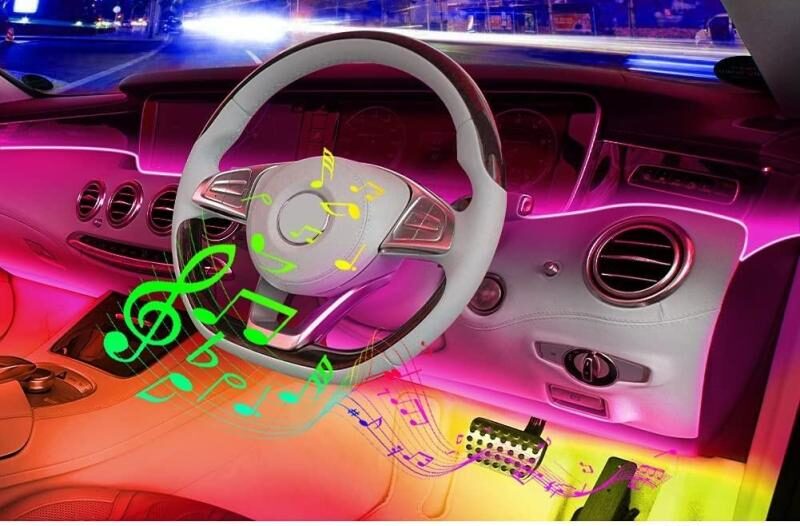LED Car Lighting – With features like better visibility, longer lifespans, and higher energy economy, LED Car Lighting has completely changed the automobile business. These benefits increase vehicle aesthetics in addition to increasing pedestrian and driver safety. This article offers a thorough overview of LED Car Lighting, emphasizing the value of LED drivers, their numerous uses, and the advantages they provide contemporary automotive systems.
Table of Contents
ToggleOverview of LED Car Lighting
Because of its longevity and efficiency, LED (Light Emitting Diode) technology is becoming more and more common in car lighting. LED Car Lighting is brighter, more energy-efficient, and has a longer lifespan than conventional incandescent lighting. They are perfect for headlights, taillights, interior and ambient lighting, and other vehicle lighting applications because of their properties.

Key Benefits of LED Car Lighting
- Energy Efficiency: LEDs use less energy than conventional bulbs, which lessens the strain on an automobile’s electrical system and increases fuel economy.
- Extended Lifespan: LED lights require less maintenance and replacement throughout their much longer lifespan.
- Enhanced Visibility: LEDs provide light that is brighter and clearer, making it easier for drivers to see at night or in bad weather, which increases overall safety.
- visual Appeal: The vehicle’s visual appeal may be increased by using LED lights to produce fashionable lighting effects both inside and outside the car.
LED Drivers: The Heart of LED Car Lighting
One essential part that controls the power to the LED Car Lighting source is an LED driver. It provides a steady current or voltage to guarantee the LEDs run safely and effectively. The dependability and performance of LED vehicle lighting systems may be greatly increased with high-quality LED drivers.
Types of LED Drivers
- Linear LED Drivers: These drivers give the LEDs a steady current and are easy to use and affordable. They work well in situations when efficiency is not the primary consideration.
- Switching LED Drivers: Using pulse-width modulation (PWM) to control current, switching drivers are more intricate than linear drivers. They are appropriate for high-power applications and provide increased efficiency.
- Matrix controllers are sophisticated LED drivers that enable the independent control of many LEDs arranged in a matrix, which makes them perfect for intricate lighting designs and adaptive lighting systems.
Automotive LED Lighting Applications
Because LED technology is adaptable, it may be used on many different sections of a car to improve both appearance and usefulness. Here are a few typical uses for LED Car Lighting in automobiles:
1. Headlights and Taillights
- LED headlights: Increase visibility at night by producing strong, focussed light. They outlast conventional halogen lamps and use less energy.
- LED taillights: Provide quicker lighting than incandescent bulbs, which helps speed up other drivers’ reactions and increase safety.
2. Interior Lighting
Ambient lighting: Makes the interior of the automobile feel opulent and cozy. LED strips with adjustable illumination colors and intensities can be mounted beneath the dashboard, seats, or door panels.
Reading Lights: To read maps or papers without straining your eyes, provide a clear, concentrated light source.
3. Indicator and Signal Lights
- Turn Signals: LED turn signals ensure that other drivers can see the vehicle’s intended direction with ease and give fast reaction times.
- Brake Lights: The prompt lighting of LED brake lights can assist minimize rear-end incidents by slowing down the reaction time of oncoming traffic.
4. Decorative and Custom Lighting
- Underbody Lighting: Show vehicles and custom builds frequently use LED strips placed beneath the vehicle to produce a striking visual impact.
- Logo Projection: To add a unique touch, when the car’s doors are opened, LED projectors may be utilized to display the logo or other graphics onto the ground.
Factors to Consider When Choosing LED Car Lighting

1. Brightness and Color Temperature
- Brightness: LED Car Lighting should have a brightness of at least 550 lumens, which is enough to increase visibility without making other drivers squint at them.
- Color Temperature: Warm white to cool blue are the color temperatures that LED lights come in. Selecting the appropriate color temperature may affect both appearance and usability.
2. Compatibility
- It is essential to ensure that the LED Car Lighting are compatible with the vehicle’s existing electrical system and fittings. Some LED lights may require specific connectors or adapters.
3. Heat Dissipation
- LEDs generate less heat than traditional bulbs, but proper heat dissipation is still crucial to prevent overheating and ensure a long lifespan. Look for LED lights with built-in heat sinks or cooling mechanisms.
4. Regulatory Compliance
- Some regions have specific regulations regarding automotive lighting. Ensure that the chosen LED lights comply with local laws and standards to avoid legal issues.
Installation and Maintenance of LED Car Lighting
Installation Tips
- Read the Manual: Always follow the manufacturer’s installation instructions to avoid damaging the vehicle’s electrical system.
- Use Proper Tools: Use appropriate tools to avoid damaging the LED lights or vehicle components during installation.
- Test Before Final Installation: Test the LED lights before finalizing the installation to ensure they work correctly and are properly aligned.
Maintenance Tips
- Regular Cleaning: Keep the LED lights clean from dust and debris to ensure optimal performance.
- Check for Loose Connections: Periodically check for any loose connections or signs of wear and tear, especially in areas exposed to vibrations or harsh conditions.
- Replace Damaged Lights Promptly: If an LED light becomes damaged or malfunctions, replace it promptly to maintain safety and performance.
Comparison of Top LED Car Lighting Solutions
| Feature | LED Lighting | Halogen Lighting | HID Lighting |
|---|---|---|---|
| Energy Efficiency | High | Low | Medium |
| Lifespan | Long (up to 50,000 hours) | Short (1,000-2,000 hours) | Medium (5,000-8,000 hours) |
| Brightness | High | Moderate | Very High |
| Heat Generation | Low | High | Moderate |
| Installation Complexity | Moderate | Easy | Complex |
| Cost | Higher initial cost, low maintenance | Low initial cost, high maintenance | High initial cost, moderate maintenance |
Conclusion
LED vehicle illumination has several advantages, including increased safety and visibility as well as lifespan and energy economy. Automobile manufacturers will likely adopt LED technology going forward, so expect even more inventive and dependable lighting options.LED Car Lighting is a useful and adaptable alternative, whether you want to enhance your car’s safety features or give it a more fashionable appeal. You can make wise selections and fully profit from this cutting-edge technology if you are aware of the different uses, advantages, and factors to take into account when choosing LED Car Lighting.











